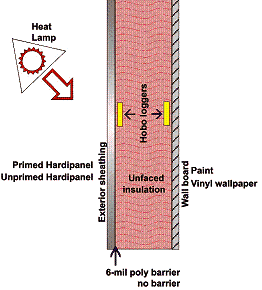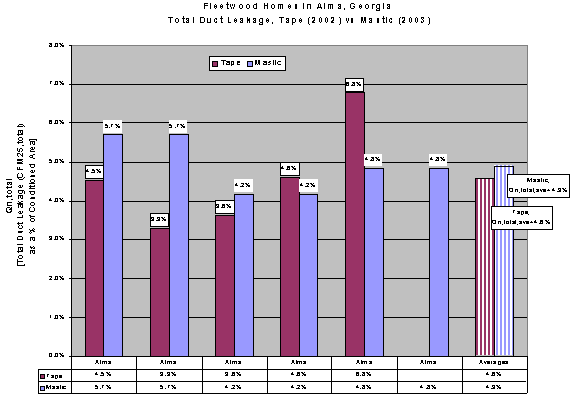- Moisture-Plagued
Southeast HUD Code Homes
A
significant number of new manufactured houses built to HUD
code and located in the hot, humid Southeast are experiencing
moisture problems. Soft wallboards, buckled floors, damaged
wood molding, and extensive mold growth are the most common
symptoms. These problems do not respond to the standard
service and repair strategies for water intrusion. (Please
see Appendix D for sample problem home inspection trip reports.)
At
the request of six manufacturers, 69 such moisture damaged
homes were investigated from 1999 to the end of reporting
year four (through March 31, 2003) to determine likely causes.
In Year 4 alone, 18 homes were investigated. One-time blower
door, duct tightness, and pressure differential measurements
were performed on all homes. Field data on ambient, crawlspace,
belly and house temperatures, plus relative humidity levels
were collected on a few of the homes. Recommendations and
reports were prepared for the manufacturers service, production,
and design staff. Field repairs were performed in most of
these homes. A general theme was found in the houses investigated.
- Air
conditioner thermostat settings (typically 68 to73 F)
set below the ambient dew point.
- Negative
pressures across the envelope from high supply duct leakage
(CFM @25Pa >10 per 100 square feet of conditioned floor
area), inadequate return air paths, interior door closures,
exhaust fans, or a combination thereof.
- Inadequate
moisture removal from disconnected return ducts, continuous
fan operation (air handler or ventilation), inadequate condensate
drainage, oversized air conditioners, or a combination thereof.
-
Moisture diffusion from the ground into the house because
of poor site drainage, inadequate crawl space ventilation,
tears in the belly board, or a combination thereof.
-
Vapor-retardant in the wrong location (i.e., vinyl or other
impermeable wall or floor coverings located on the colder
surfaces).
- Recommended
solutions provided to the manufacturers to eliminate moisture
problems included:
- Maintain
air conditioning thermostat settings above the ambient dew
point (at least 75F).
- Eliminate
long-term negative pressures created by air handler fans
or ventilation equipment.
- Tightly
seal all ductwork and provide adequate return air pathways.
- Enhance
moisture removal from the conditioned space by correct equipment
sizing and maintenance.
-
Eliminate ground source water and provide an adequate moisture
barrier for the floor assembly.
-
If possible, remove vapor barriers located on the wrong
surfaces.
Research
continues to determine if these steps will be sufficient to
prevent problems even when vapor barriers are incorrectly
located in homes in the hot, humid climate. Preliminary results
are encouraging. One manufacturer has not reported a single
new moisture problem in any of the homes produced since 2000
in a factory that previously had a significant number of problem
homes. Steps taken by the factory were inclusion of airtight
duct systems (a zero net-cost increase), right-sized cooling
systems (a negative cost), return air ducts from all bedrooms
(a cost of about $15), installation of a ground vapor barrier
(no change from previous practice).
 |
Figure
54. Wall cross section. |
Homes
of Merit: In 2002, researchers performed multiple diagnostic
tests on a home located in Marathon, Florida that was experiencing
"mold problems." Researchers determined that the mechanical
system was significantly oversized and that the home was operating
under negative pressure when the system was operational.
The home's owner exacerbated humidity problems by leaving
the fan in the "on" mode. On-site relative humidity readings
showed that indoor and outdoor relative humidity were the
same, approximately 70%.
Palm
Harbor Homes: Palm Harbor Homes, James Hardie,
and FSEC performed two separate drywall assembly tests to
determine the cause of some moisture damage occurring in homes
sheathed with Hardipanel. Hobo dataloggers recorded temperature
and relative humidity measurements inside the assembled panels
on eight different wall panel configurations. (Please see
Figure 54).
Results
determined that the unprimed, unwrapped sheathing performed
best. The painted drywall assemblies allowed the greatest
moisture movement - or wall assembly drying. (Please see
Table 14.) The vinyl-covered drywall held moisture longest,
recording the slowest drying time. Adding perforations to
the vinyl reduced the drying time. Though more perforations
than the amount used in this test would be necessary to make
this an effective option.
| Test
Panel |
Drywall |
Insulation |
Wall
Wrap |
Sheathing |
| #1 |
vinyl |
unfaced |
none |
primed |
| #2 |
vinyl |
unfaced |
none |
unprimed |
| #3 |
vinyl |
unfaced |
housewrap |
primed |
| #4 |
perforated
vinyl |
unfaced |
none |
primed |
| #5 |
housewrap
glued to drywall |
unfaced |
housewrap |
primed |
| #6 |
vinyl |
unfaced |
thermoply |
primed |
| #7 |
painted |
unfaced |
none |
primed |
| #8 |
painted |
unfaced |
none |
unprimed |
Table
14.Hardiepanel
exterior wall configurations.
In
2002, two Palm Harbor homes with comfort problems were tested
in Ocala and Okahumpka, Florida and one high bill complaint
was investigated in Odessa, Florida. Duct leakage testing
and infrared imaging revealed a duct disconnect near the attic
crossover in the Ocala home. Inspections with the IR camera
found no insulation problems in the Odessa home. Ductblaster
and blower door tests revealed airtight duct and envelope
systems. Other than an oversized air conditioning system,
there were no obvious reasons for the high bills.
Fleetwood
Homes: In 2002, four Fleetwood factories in Southern Georgia
were visited to investigate possible causes of moisture related
building failures found in homes installed in hot, humid climates.
The factories were located in Douglas, Alma, Pearson, and
Willacootche. (Please see Figure 55.)
Six
Fleetwood homes, all in Florida, were tested for moisture
and mold damage from April 2002 through March 2003. All of
the homes had damaged flooring due in part to a lack of ground
cover and poor crawlspace ventilation. Damage to the floor
in one home was exacerbated by a plumbing leak. Only one home
had moisture damage to the wallboard material, and this home
showed a history of thermostat settings below 72 F. A report
for each home was submitted to Fleetwood for corrective measures.
One additional high bill complaint in Cobb, Georgia was investigated
during this reporting period.
Southern
Energy Homes: During Year 2001, 12 homes were field tested
in the Houma, Louisiana area. Some of the homes had new moisture
damage. Others were rechecks of previous moisture problems
already repaired by SEH personnel. FSEC inspectors reported
improper repairs and recommended additional dealer and staff
training. An additional five homes were field tested in Houma
during this reporting period, with another home in Mississippi
and one in Alabama also field tested.

Figure
55. Testing Results from Fleetwood Homes Plant in Alma,
Georgia illustrate that tape sealed ducts can result in total
(initial) duct leakage under Qn=<6% and that implementing
mastic sealing without duct assembly improvements does not
necessarily improve duct tightness.
Floor
Decking Material Lab Tests: FSEC conducted initial investigations
on manufacturers' floor decking materials, looking for ways
to enhance the material's performance by eliminating moisture
diffusion, floor warping, and mold/mildew. Over a dozen materials
were tested without finding an effective product.
Blue
Sky Foundation: Blue Sky Foundation, in coordination
with FSEC, conducted an evaluation of energy efficiency and
the moisture damage potential in 16 North Carolina homes in
the summer of 2001. Blue Sky foundation proposed that the
energy and moisture evaluation focus on the building envelope
integrity, HVAC duct systems, and the moisture impact of unvented
space heaters. All of the homes in the study were manufactured
models located in Carteret and Craven counties, each located
on the North Carolina coast. Field teams gathered additional
energy and moisture information from homeowners.
Only
three of the 15 tested homes recorded moisture and/or mildew
problems. Because of the small sample size, the results are
mostly anecdotal and would need to be evaluated within a larger
data set. Planning for this is underway. Data from the
summer field program as well as the final report is now on
the Internet at bluesky.inetogether.com/cgi-bin/show_page.cgi?mhousing.
|





